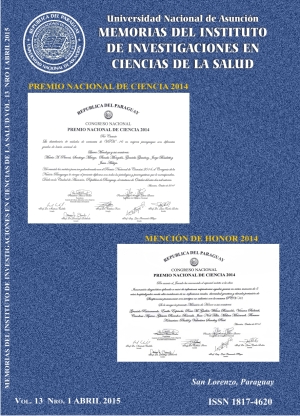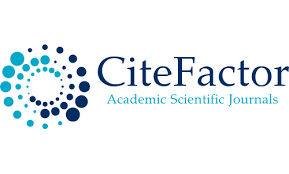Primer reporte de un caso importado de Malaria por Plasmodium ovale curtisi en Paraguay, confirmado por diagnóstico molecular
Palabras clave:
Plasmodium ovale curtisi, caso importado, África, Paraguay, PCR múltiple semianidada.Resumen
En países donde el Plasmodium ovale no es común, los microscopistas tienden a identificarlo de manera errónea como Plasmodium vivax. En este trabajo reportamos la identificación de la especie P. ovale curtisi por el método de PCR múltiple semianidada (SnM-PCR) y la secuenciación de la subunidad pequeña del gen del ARN 18S, en un paciente paraguayo de 44 años de edad que vino en el 2.013 de Guinea Ecuatorial, África Occidental, a quien se le diagnosticó una infección por P. vivax por microscopía convencional. El empleo de métodos moleculares para la identificación de casos importados de infección con especies del género Plasmodium es uno de los objetivos principales en el control y la prevención de la malaria en Paraguay, teniendo en cuenta que el país se encuentra en fase de pre-eliminación de la enfermedad.
Descargas
Citas
WHO. World Malaria Report: 2013. Geneva: WHO; 2013.
Daneshvar C, Davis TM, Cox-Singh J, Rafa'ee MZ, Zakaria SK, Divis PC, et al. Clinical and laboratory features of human Plasmodium knowlesiinfection. Clin Infect Dis. 2009; 49(6):852-60.
Doderer-Lang C, Atchade PS, Meckert L, Haar E, Perrotey S, Filisetti D, et al. The ears of the African elephant: unexpected high seroprevalence of Plasmodium ovale and Plasmodium malariae in healthy populations in Western Africa. Malar J. 2014; 13:240.
Fuehrer HP, Starzengruber P, Swoboda P, Khan WA, Matt J, Ley B, et al. Indigenous Plasmodium ovale malaria in Bangladesh. Am J Trop Med Hyg. 2010.; 83(1):75-8
Marathe A, Date V, Shah HN, Tripathi JR. Plasmodium ovale a case report from Gujarat. J Vector Borne Dis. 2006; 43(4):206-8.
Nguyen HV, van den Eede P, van Overmeir C, Thang ND, Hung le X, D'Alessandro U, et al. Marked age-dependent prevalence of symptomatic and patent infections and complexity of distribution of human Plasmodium species in central Vietnam. Am J Trop Med Hyg. 2012; 87(6):989-95.
Cabrera BD, Arambulo PV. Malaria in the Republic of the Philippines. A review. Acta Trop. 1977; 34(3):265-79.
Baird JK, Purnomo, Masbar S. Plasmodium ovale in Indonesia. Southeast Asian J Trop Med Public Health. 1990; 21(4):541-4.
Mueller I, Taime J, Ibam E, Kundi J, Lagog M, Bockarie M, et al. Complex patterns of malaria epidemiology in the highlands region of Papua New Guinea. P N GMed J. 2002; 45(3-4):200-5.
Incardona S, Chy S, Chiv L, Nhem S, Sem R, Hewitt S, et al. Large sequence heterogeneity of the small subunit ribosomal RNA gene of Plasmodium ovale in Cambodia. Am J Trop Med Hyg. 2005; 72(6):719-24.
Zhou M, Liu Q, Wongsrichanalai C, Suwonkerd W, Panart K, Prajakwong S, et al. High prevalence of Plasmodium malariae and Plasmodium ovale in malaria patients along the Thai-Myanmar border, as revealed by acridine orange staining and PCR-based diagnoses. Trop Med Int Health. 1998; 3(4):304-12.
Lysenko AJ, Beljaev AE. An analysis of the geographical distribution of Plasmodium ovale. Bull World Health Organ. 1969; 40(3):383-94.
Limongi JE, Costa DC, Carvalho LH, Lopes IS, Silva AA, Ferreira MS. Plasmodium ovale malaria in Brazil: report of an imported case with a prolonged incubation period. J Infect Dev Ctries. 2014; 8(4):554-7.
Li Y, Wang G, Sun D, Meng F, Lin S, Hu X, et al. A case of Plasmodium ovale wallikeri infection in a Chinese worker returning from West Africa. Korean J Parasitol. 2013; 51(5):557-62.
Senn H, Alattas N, Boggild AK, Morris SK. Mixed-species Plasmodium falciparum and Plasmodium ovale malaria in a paediatric returned traveller. Malar J. 2014;3:78.
Lim YA, Mahmud R, Chew CH, Thilaganathan T, Chua KH. Plasmodium ovale infection in Malaysia: first imported case. Malar J. 2010; 9:272.
Sutherland CJ, Tanomsing N, Nolder D, Oguike M, Jennison C, Pukrittayakamee S, et al. Two non-recombining sympatric forms of the human malaria parasite Plasmodium ovale occur globally. J Infect Dis. 2010; 201(10):1544–50.
Nolder D, Oguike MC, Maxwell-Scott H, Niyazi HA, Smith V, Chiodini PL, et al. An observational study of malaria in British travellers: Plasmodium ovale wallikeri and Plasmodium ovale curtisi differ significantly in the duration of latency. BMJ Open. 2013; 3(5): e002711
SENEPA. Programas del SENEPA: Programa Nacional de Control del Paludismo. Agosto 2013 (acceso 23 febr 2015). En: Blog informativo del Servicio Nacional de Erradicación del Paludismo – SENEPA /Internet/. SENEPA, 2013. Disponible en:
http://programassenepa.blogspot.com/p/paludismo.html
Arbo A. Paraguay es campeón contra la malaria /Internet/. ABC color. 9 nov 2012; Sección Nacionales. (acceso 19 febr 2015). Disponible en: http://www.abc.com.py/nacionales/paraguay-obtiene-premio-campeones-contra-la-malaria-475774.html
Ta Tang TH, Ali-Tammam M, Lanza M, Rubio JM. Detección e identificación de plasmodios mediante PCR múltiple semianidada. En: Merino LA, Giusiano G. Manual de métodos moleculares para estudios microbiológicos. Buenos Aires: Asociación Argentina de Microbiología; 2011. p. 110.
Rubio JM, Benito A, Berzosa PJ, Roche J, Puente S, Subirats M et al. Usefulness of seminested multiplex PCR in surveillance of imported malaria in Spain. J Clin Microbiol. 1999; 37(10):3260-4.
Rubio JM, Post RJ, van Leeuwen WM, Henry MC, Lindergard G, Hommel M. Alternative polymerase chain reaction method to identify Plasmodium species in human blood samples: the semi-nested multiplex malaria PCR (SnM-PCR). Trans R Soc Trop Med Hyg. 2002; 96(1):199-204.
WHO. World Malaria Report: 2012. Geneva: WHO; 2012.
Milne LM, Kyi MS, Chiodini PL, Warhurst DC. Accuracy of routine laboratory diagnosis of malaria in the United Kingdom. J Clin Pathol. 1994; 47(8):740-2.
Dinkoa B, Mary C. Oguike MC, Larbi JA, Bousema T, Sutherland CJ. Persistent detection of Plasmodium falciparum, P. malariae, P. ovale curtisi and P. ovale wallikeri after ACT treatment of asymptomatic Ghanaian school-children. International Journal for Parasitology: Drugs and Drug Resistance. 2013; 3: 45–50.
WHO. Malaria elimination: A field manual for low and moderate endemic countries. Geneva: WHO; 2007.
Alexandre MA, Ferreira CO, Siqueira AM, Magaliahães BL, Mourão MP, Lacerda MV, et al. Severe plasmodium vivax malaria, Brazilian Amazon. Emerg Infect Dis. 2010; 16(10):1611-4.
WHO. Guidelines for the treatment of malaria. Geneva: WHO; 2006.














